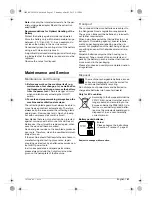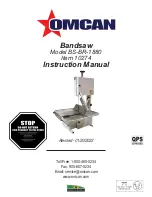
40
| English
1 619 P12 706 • 5.3.15
Starting Operation
Inserting the battery
Use only original BTI batteries with the voltage
listed on the nameplate of your power tool.
Us-
ing other batteries can lead to injuries and pose
a fire hazard.
Insert the charged battery
1
from the front into the
base of the power tool. Push the battery completely
into the base until the red stripe can no longer be
seen and the battery is securely locked.
Switching On and Off
To
start
the machine,
first
push the lock-off button
for the On/Off switch
3
and
then
press the On/Off
switch
4
and keep it pressed.
To
switch off
the machine, release the On/Off
switch
4
.
Note:
For safety reasons, the On/Off switch
4
can-
not be locked; it must remain pressed during the
entire operation.
To save energy, only switch the power tool on
when using it.
Run-on Brake
An integrated run-on brake reduces the run-on pe-
riod of the saw blade after switching off the ma-
chine.
Temperature Control/Overload Protection
Indicator
The red LED indicator
16
will help you in protecting
the battery against overheating and the motor
against overloading.
When the LED indicator
16
continuously lights up
red
, the temperature of the battery is too high and
the machine switches off automatically.
– Switch the power tool off.
– Allow the battery to cool down before continuing
to work.
The LED indicator
16
flashes red
, the power tool is
blocked and switches off automatically.
Remove the power tool from the workpiece.
The power tool will continue to work as soon as the
blockage is rectified.
Protection Against Deep Discharging
The lithium-ion battery is protected against deep
discharging by the “Electronic Cell Protection
(ECP)”. When the battery is empty, the machine is
switched off by means of a protective circuit: The
inserted tool no longer rotates.
Switching on the LED Work Area Illumination
The power light
26
lights up when the On/Off
switch
4
is slightly or completely pressed, and al-
lows the work area to be illuminated when lighting
conditions are insufficient.
Working Advice
Protect saw blades against impact and shock.
Guide the machine evenly and with light feed in the
cutting direction. Excessive feed significantly re-
duces the service life of the saw blade and can
cause damage to the power tool.
Sawing performance and cutting quality depend
essentially on the condition and the tooth form of
the saw blade. Therefore, use only sharp saw
blades that are suited for the material to be worked.
Sawing Wood
The correct selection of the saw blade depends on
the type and quality of the wood and whether
lengthway or crossway cuts are required.
When cutting spruce lengthways, long spiral chips
are formed.
Beech and oak dusts are especially detrimental to
health. Therefore, work only with dust extraction.
Sawing with Parallel Guide (see figure D)
The parallel guide
32
enables exact cuts along a
workpiece edge and cutting strips of the same di-
mension.
Set the desired cutting width at the outer edge of
the base plate using the scale on the guides of the
parallel guide/guide rail adapter (see figure D).
Sawing with Auxiliary Guide (see figure F)
For sawing large workpieces or straight edges, a
board or strip can be clamped to the workpiece as
an auxiliary guide; the base plate of the circular saw
can be guided alongside the auxiliary guide.
Sawing with Guide Rail (see figure E)
The guide rail
34
is used to carry out straight cuts.
Note:
Use the guide rail
34
only for right-angled
cuts. When using for mitre cuts, the guide rail
34
can become damaged.
The adhesive coating prevents the guide rail from
slipping and protects the surface of the workpiece.
The coating of the guide rail allows the circular saw
to glide easily.
Fasten the guide rail
34
to the workpiece using suit-
able clamping devices, e.g. screw clamps. Put the
power tool with mounted guide rail adapter on the
guide rail.
The guide rail 34 must not extend beyond the
face side of the workpiece where the cut is to be
started.
Switch the machine on and guide it in the cutting
direction applying moderate and steady feed.
Working with parallel guide/guide rail adapter
and vacuum hose
First mount the extraction adapter
29
with vacuum
hose
30
and then the parallel guide/guide adapter
32
.
OBJ_BUCH-2434-001.book Page 40 Thursday, March 5, 2015 2:19 PM


































